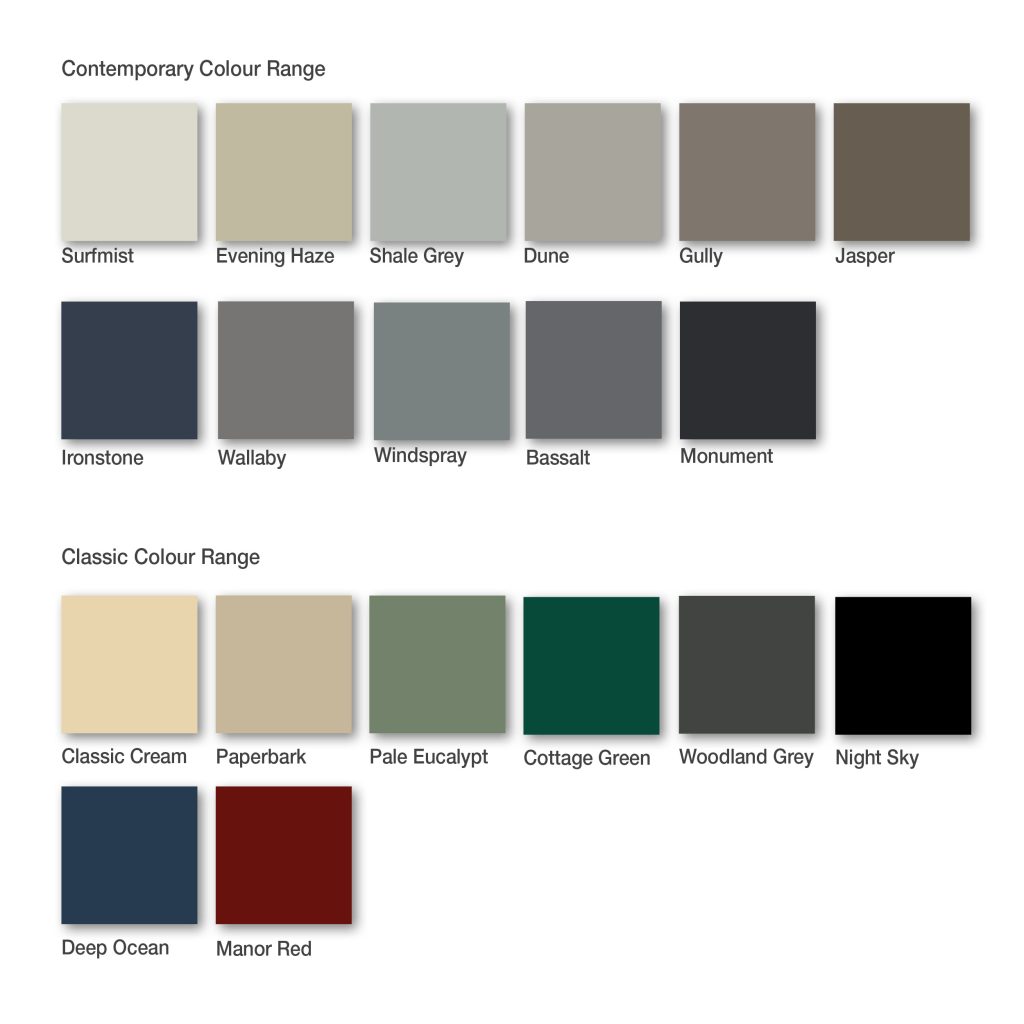Your ultimate guide to Colorbond vs tile roofs
When it comes to choosing the colours, materials and finishes for your gorgeous new facade, it’s important not to neglect the roofing materials. While you may not even think about the roof once your new home is built, it’s crucial to remember that the roof takes up 40% to 50% of your facade and greatly impacts your overall street appeal.
Now, you may be wondering what material is best for your new home. At Montgomery Homes, we’re committed to offering our clients the very best materials available on the market, including Colorbond Steel and durable Bristile concrete tiles, both available in a huge range of colours and finishes.
To simplify the design process, we’ve put together a complete guide to Colorbond vs tile roofs.
Colorbond vs tiles: Durability
Durability is one of the big-ticket items when comparing Colorbond vs tiles. Both materials are made to last — but which one will last the longest?
How long do Colorbond roofs last?
Colorbond Steel has a major advantage over concrete tiles because the product has been tried and tested in harsh Australian weather conditions. From heatwaves to cold snaps, rain, wind, dust and hail, Australia has ever-changing weather — and Colorbond has tested their steel roof panels in it all.
Colorbond Steel roof panels offer five layers of protection and undergo regular corrosion testing, durability testing and laboratory testing to ensure their roof panels provide life-long quality. In fact, there are currently more than 12,000 panels across Australia undergoing testing in moderate to severe marine, tropical and industrial environments.
With all of this in mind, the minimum Colorbond roof lifespan is around 70 years (so long as you care for it properly).
How long do concrete tiles last?
Concrete tiles, on the other hand, are durable by nature and will continue to perform for years to come — if they’re kept in good condition. In fact, a tile roof can last up to 100 years with regular maintenance, repairs and restoration.
It’s important to note that concrete tiles (or other materials like terracotta, clay or slate) can become brittle in certain environments and can get damaged if struck by a huge force, e.g. unusually large hailstones. However, they tend to perform very well in coastal areas with problematic salt air and corrosion.
To sum it up, if you compare concrete roof tiles vs Colorbond and want a durable, low-maintenance solution, we recommend Colorbond Steel.
Colorbond vs tiles: Aesthetic
The next most important thing to consider is the aesthetic of your roofing materials. This means colour, texture, guttering, fascia and how the tiles (or panels) are laid out. Here’s a quick comparison of Colorbond roofs and tiled roof colours.
Tile roof colours & designs
Tiles are a traditional roofing material in Australia — in fact, you’ll find most heritage-listed sites have tiles rather than corrugated iron or steel panels. Available in a wide range of profiles, patterns and tiled roof colours, traditional tiles can add value and charm to the appearance of your home.

Colorbond roof colours & designs
Colorbond Steel is highly sought after by modern homeowners thanks to the sleek matte finish and the contemporary range of colours. Colorbond offers a selection of custom colours and you can match the colours to your gutters and fascia to maintain the consistency of your facade design.

In the end, the choice is yours when it comes to a Colorbond vs tile roof — both have their own unique benefits and characteristics, so it all comes down to personal preference!
Colorbond vs tiles: Thermal Efficiency
Thermal efficiency refers to how well your home retains heat — considering our muggy heatwaves and unforgiving cold snaps here in Australia, thermal efficiency is an important factor to consider for your new home build!
Your roofing materials play a major role in determining whether your home is warm in winter and cool in summer. In a perfect world, your roofing materials will reflect the sun’s rays and keep air conditioning costs down.
When comparing a Colorbond Steel roof vs concrete tiles in terms of thermal efficiency, both options provide adequate thermal insulation.
Using solar reflection technology, Colorbond reflects more of the sun’s heat and ensures you’re comfortable in summer and warmer in winter. Concrete tiles tend to absorb heat for a comfortable temperature indoors in winter.
Is sarking required for a Colorbond roof?
To enhance the thermal efficiency of your home, we offer sarking as a standard inclusion in all of our new home builds. Sarking is a pliable membrane — similar to a second skin — that sits under your roof. It provides thermal insulation, protection against burning embers in bushfire-prone areas, prevents dust from entering your home and can even help control condensation to prevent mould growth.
Colorbond vs tiles: Maintenance
To keep your roof looking fresher for longer, we recommend regular cleaning and maintenance. Over time, your roofing materials will gather dirt, dust, bird droppings, and so much more — so to keep your roof in top condition, regular washes are recommended.
If we compare the maintenance of Colorbond vs tile roofs, Colorbond is the clear winner. With a smooth steel finish, cleaning and washing your roof is simple — what little maintenance needs to be done, there’s almost no chance of damaging the steel sheets.
On the other hand, tiles can have growths like moss and mould, which is why it is important to keep on top of your roof maintenance. The rough concrete finish can be harder to clean, but a high-pressure hose should be able to do the trick (with the help of some chemicals).
Colorbond vs tiles: Costs
Last, but certainly not least, you need to consider Colorbond vs tile roof costs. Both options are durable and can add incredible value to your home, but you will need to weigh these pros and cons against the price of concrete tiles and new Colorbond roof costs.
How much does a concrete tile roof cost?
Concrete tiles are the more affordable option in the short term if you are building a home independently. However, you will need to consider the additional costs related to maintenance and repairs or even replacing the tiles some time in the future.
Because concrete tiles are heavier than Colorbond Steel, you will also need to consider the cost of additional beams to support the tiled roof.
How much does a Colorbond roof cost?
Colorbond roof prices are usually more expensive than concrete tiles, but they require less maintenance and repairs. Thanks to their light nature, Colorbond roof panels require less support, too, so money can also be saved there.
At Montgomery Homes, the cost of a tile roof is included in the overall cost of your new home build. However, if you would prefer to upgrade to a Colorbond Steel roof, simply let us know and we can add this to the cost of your new home build.
Compare tiles vs Colorbond roofs with the professionals at Montgomery Homes!
Can’t choose between the benefits of Colorbond roofs vs tile roofs? Contact us to discuss your options today! You’re invited to visit our Selections Gallery in Sydney or Belmont (15 minutes from the Newcastle CBD) where we have countless Colorbond and concrete tile roof colours on display, so you can see the real difference between the two options.
Contact us online or via:
- 02 4013 6592 in Newcastle
- 02 8020 5952 in Sydney
- 02 4302 4199 on the Central Coast.
Our team is on hand to help you weigh up the pros and cons of Colorbond or tile roof materials!
Explore our other blog posts
Similar Blogs
- All Articles
- Styling & Inspiration


































